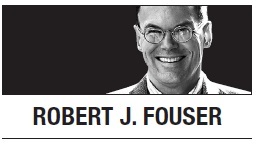[Robert Fouser] Travels in multicultural Korea
By Robert J. FouserPublished : June 20, 2017 - 17:42
 Language is always changing, but the changes often escape us because they occur slowly. During a recent visit to Gochang and Gwangju, I noticed many changes that are harder to detect in busy Seoul. The changes are closely related to the multiculturalization of Korean society over the past 20 years.
Language is always changing, but the changes often escape us because they occur slowly. During a recent visit to Gochang and Gwangju, I noticed many changes that are harder to detect in busy Seoul. The changes are closely related to the multiculturalization of Korean society over the past 20 years.On the way to Gochang, I changed from the KTX to a local train in Iksan. On the train, I heard two women speaking a Central Asian language. One of the women received several phone calls and spoke fluent Korean. But more than fluent, her Korean was natural, the type of use that can only be learned from sustained contact with native speakers over time.
After a few stops, someone sat in the vacant seat next to me. I said hello in Korean and the person responded kindly in return. The person was not surprised that I spoke Korean and didn’t comment on it. We didn’t talk much and I politely said goodbye when my stop came up.
In the 1980s and well into the 1990s, a train ride outside of Seoul was different. Foreigners were rarer and Korean-speaking foreigners were even rarer. Passengers would ask questions and share food and drink. Traveling was a social experience rather than a time to look out the window and muse.
Until the late 1980s, the two largest groups of foreigners living in Korea were ethnic Chinese with Taiwanese citizenship and Americans, most of whom were connected to the US military. There was a smaller contingent of businesspeople, diplomats, language teachers, missionaries and students.
Things began to change with democratization in the late 1980s. Foreign workers from South and Southeast Asia began to fill jobs that Koreans had started to avoid. In the early 1990s, ethnic Koreans from China started coming to Korea. The English boom in the 1990s stimulated an increase in the number of native-speaker teachers.
The economic crisis in the late 1990s caused a temporary dip in the number of foreigners, but the inflow began anew with the economic recovery. Korean men in rural areas found it increasingly difficult to get married and began to marry foreign women, mostly from Southeast Asia. The media labeled these families as “multicultural” and the government began to address their needs in the late 2000s.
In Gochang, I visited the Dolmen Site, a UNESCO World Heritage site that contains the largest collection of dolmen -- prehistoric stone graves -- in the world. At the Gochang Dolmen Museum, a young woman greeted me in fluent Korean. Toward the end of our short conversation, she told me that she was from China and therefore a foreigner, too. Her Korean was so good that I could barely tell that she was not a native speaker.
After walking around the Dolmen Site for several hours in the sun, I went back to the museum to call for a taxi to the Gochang Pansori Museum. The Chinese woman called a taxi and made small talk with her Korean colleague. The Korean colleague said that so many “foreigners” living in Gochang now have Korean citizenship that he no longer assumes that nonethnic Koreans are foreigners.
Near the end of a long day, I finally arrived in Gwangju and stumbled on a Chinese restaurant for dinner. The restaurant opened in 1945 and had an old-school feel about it. It was late and there weren’t many customers, so I could hear a conversation between the woman who greeted me and a customer. They moved easily from Korean to Chinese and often mixed the languages.
From a day of encounters in Gochang and Gwangju, I became clear that Korea is becoming much more diverse. Foreigners are not just coming to Korea to live and work; they are coming to Korea to put down roots and stay. Learning Korean is now the norm. The days when “foreigners” meant white Americans are over and many foreigners are becoming Korean.
Despite the frequent use of the word “multicultural,” current government policy supports assimilation. The series of classes that foreigners who want citizenship or permanent residency are required to take includes the word “social integration” in the title.
Integration creates stability and social cohesion, but the pressure to assimilate can also become oppressive and alienating. As Korea welcomes even more immigrants, the challenge will be to promote integration without creating an alienated underclass. It will not be easy, but Korea is good at dealing with big changes in a short time. Expect to be surprised.
By Robert J. Fouser
Robert J. Fouser, a former associate professor of Korean language education at Seoul National University, writes on Korea from Pawtucket, Rhode Island. He can be reached at robertjfouser@gmail.com. -- Ed.








![[Graphic News] More Koreans say they plan long-distance trips this year](http://res.heraldm.com/phpwas/restmb_idxmake.php?idx=644&simg=/content/image/2024/04/17/20240417050828_0.gif&u=)
![[KH Explains] Hyundai's full hybrid edge to pay off amid slow transition to pure EVs](http://res.heraldm.com/phpwas/restmb_idxmake.php?idx=644&simg=/content/image/2024/04/18/20240418050645_0.jpg&u=20240419100350)





![[From the Scene] Monks, Buddhists hail return of remains of Buddhas](http://res.heraldm.com/phpwas/restmb_idxmake.php?idx=652&simg=/content/image/2024/04/19/20240419050617_0.jpg&u=20240419175937)

![[KH Explains] Hyundai's full hybrid edge to pay off amid slow transition to pure EVs](http://res.heraldm.com/phpwas/restmb_idxmake.php?idx=652&simg=/content/image/2024/04/18/20240418050645_0.jpg&u=20240419100350)

![[Today’s K-pop] Illit drops debut single remix](http://res.heraldm.com/phpwas/restmb_idxmake.php?idx=642&simg=/content/image/2024/04/19/20240419050612_0.jpg&u=)